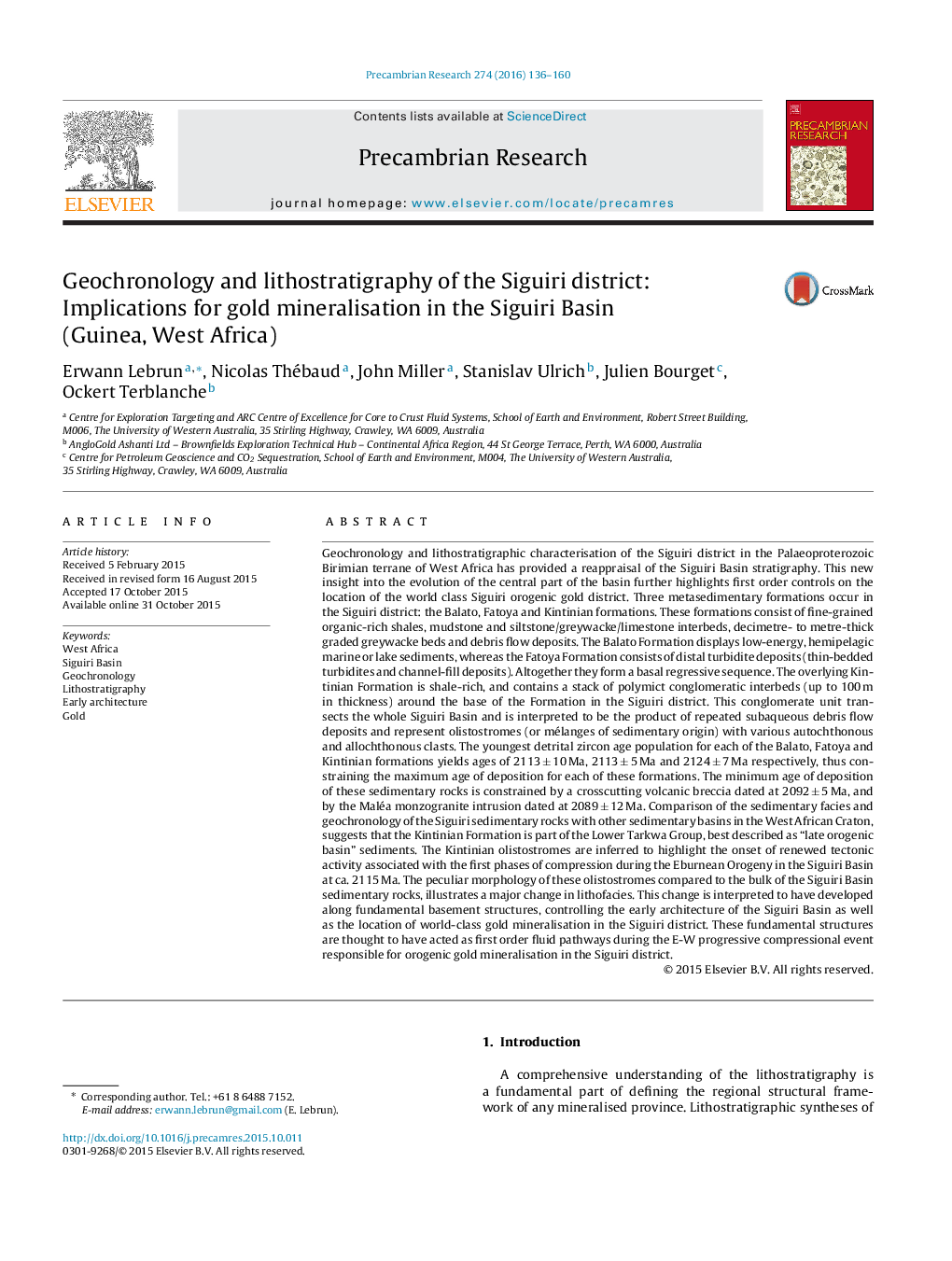| کد مقاله | کد نشریه | سال انتشار | مقاله انگلیسی | نسخه تمام متن |
|---|---|---|---|---|
| 4722504 | 1639601 | 2016 | 25 صفحه PDF | دانلود رایگان |

• We give a reappraisal of the lithostratigraphy of the central Siguiri Basin.
• We support this reappraisal with SHRIMP dating of detrital and igneous zircons.
• We suggest that the central Siguiri Basin is part of the Tarkwa Group.
• These late basin sediments highlight the early architecture of the Siguiri Basin.
• This early architecture can be used to improve orogenic gold targeting.
Geochronology and lithostratigraphic characterisation of the Siguiri district in the Palaeoproterozoic Birimian terrane of West Africa has provided a reappraisal of the Siguiri Basin stratigraphy. This new insight into the evolution of the central part of the basin further highlights first order controls on the location of the world class Siguiri orogenic gold district. Three metasedimentary formations occur in the Siguiri district: the Balato, Fatoya and Kintinian formations. These formations consist of fine-grained organic-rich shales, mudstone and siltstone/greywacke/limestone interbeds, decimetre- to metre-thick graded greywacke beds and debris flow deposits. The Balato Formation displays low-energy, hemipelagic marine or lake sediments, whereas the Fatoya Formation consists of distal turbidite deposits (thin-bedded turbidites and channel-fill deposits). Altogether they form a basal regressive sequence. The overlying Kintinian Formation is shale-rich, and contains a stack of polymict conglomeratic interbeds (up to 100 m in thickness) around the base of the Formation in the Siguiri district. This conglomerate unit transects the whole Siguiri Basin and is interpreted to be the product of repeated subaqueous debris flow deposits and represent olistostromes (or mélanges of sedimentary origin) with various autochthonous and allochthonous clasts. The youngest detrital zircon age population for each of the Balato, Fatoya and Kintinian formations yields ages of 2113 ± 10 Ma, 2113 ± 5 Ma and 2124 ± 7 Ma respectively, thus constraining the maximum age of deposition for each of these formations. The minimum age of deposition of these sedimentary rocks is constrained by a crosscutting volcanic breccia dated at 2092 ± 5 Ma, and by the Maléa monzogranite intrusion dated at 2089 ± 12 Ma. Comparison of the sedimentary facies and geochronology of the Siguiri sedimentary rocks with other sedimentary basins in the West African Craton, suggests that the Kintinian Formation is part of the Lower Tarkwa Group, best described as “late orogenic basin” sediments. The Kintinian olistostromes are inferred to highlight the onset of renewed tectonic activity associated with the first phases of compression during the Eburnean Orogeny in the Siguiri Basin at ca. 2115 Ma. The peculiar morphology of these olistostromes compared to the bulk of the Siguiri Basin sedimentary rocks, illustrates a major change in lithofacies. This change is interpreted to have developed along fundamental basement structures, controlling the early architecture of the Siguiri Basin as well as the location of world-class gold mineralisation in the Siguiri district. These fundamental structures are thought to have acted as first order fluid pathways during the E-W progressive compressional event responsible for orogenic gold mineralisation in the Siguiri district.
Journal: Precambrian Research - Volume 274, March 2016, Pages 136–160